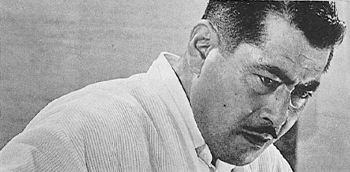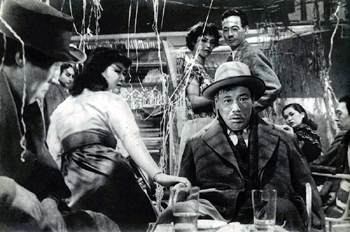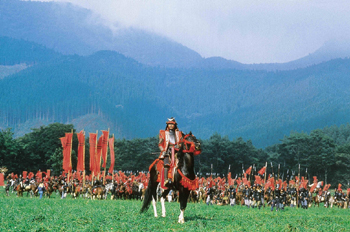Eighteen Classics to Screen During Festival at Stanford Theater Source: Stanford Theater, akirakurosawa.com
The historic Stanford Theater in Palo Alto, California reopens this weekend after remodeling and is off to a huge and auspicious start. Beginning February 20 and running through March 30, the theater will feature an Akira Kurosawa Film Festival. The festival will feature no less than eighteen of Kurosawa’s classic films, starting with THE SEVEN SAMURAI, considered by many to be the greatest film ever to come out of Japan. The Stanford Theatre first opened in 1925, and it served for decades as Palo Alto`s premier movie house. In 1987, after a blockbuster Fred Astaire Film Festival, the David and Lucile Packard Foundation bought the theatre and restored it to its original splendor. It is now owned and operated by the non-profit Stanford Theatre Foundation, presenting classic Hollywood films. The renovated Stanford Theatre quickly became America`s most popular place to watch classic Hollywood movies. More people saw CASABLANCA there on its 50th anniversary in 1992 than anywhere else in America. Before evening performances and during intermissions, the Stanford Theater features the “Mighty Wurlitzer Organ”. As single-screen theaters increasingly become more and more rare, the Stanford Theater has weathered the passing of time and thrived by showing classic films and unique, retrospective film festivals.
Biography from akirakurosawa.com:
The most well-known of all Japanese directors, the great irony about Akira Kurosawa`s career is that he is far more popular outside of Japan than he is in Japan. The son of an army officer, Kurosawa studied art before gravitating to film as a means of supporting himself. He served seven years as an assistant to director Kajiro Yamamoto before he began his own directorial career with SANSHIRO SUGATA (1943), a film about the 19th-century struggle for supremacy between adherents of judo and ju-jitsu that so impressed the military government, he was prevailed upon to make a sequel (SANSHURO SUGATA PART II).
Following the end of World War II, Kurosawa`s career gathered speed with a series of films that cut across all genres, from crime thrillers to period dramas -- among the latter, his RASHOMON (1951) became the first postwar Japanese film to find wide favor with Western audiences, and simultaneously introduced leading man Toshiro Mifune to Western viewers. It was Kurosawa`s THE SEVEN SAMURAI (1954), however, that made the largest impact of any of his movies outside of Japan. Although heavily cut on its original release, this three-hour-plus medieval action drama, shot with painstaking attention to both dramatic and period detail, became one of the most popular of Japanese films of all time in the West, and every subsequent Kurosawa film has been released in the U.S. in some form, even if many -- most notably THE HIDDEN FORTRESS (1958) -- were cut down in length. At the same time, American and European filmmakers began taking a serious look at Kurosawa`s movies as a source of plot material for their own work -- RASHOMON was remade as THE OUTRAGE, in a western setting, while YOJIMBO was remade by Sergio Leone as A FISTFULL OF DOLLARS (1964). THE SEVEN SAMURAI (1954) fared best of all, serving as the basis for John Sturges` THE MAGIFICENT SEVEN (which had been the original title of Kurosawa`s movie), in 1960; the remake actually did better business in Japan than the original film did. In the early 1980s, an unfilmed screenplay of Kurosawa`s also served as the basis for RUNAWAY TRAIN (1985), a popular action thriller. Kurosawa`s movies subsequent to his period thriller SANJURO (1962) abandoned the action format in favor of more esoteric and serious drama, including his epic length medical melodrama RED BEARD (1965). In recent years, despite ill-health and the problems getting financing for his more ambitious films, Kurosawa has remained the most prominent of Japanese filmmakers. With his Westernized style, Kurosawa has always found a wider audience and more financing opportunities in Europe and America than he has in his own country. A sensitive romantic at heart, with a sentimental streak that occasionally rises forcefully to the surface of his movies, his work probably resembles that of John Ford more closely than it does any of his fellow Japanese filmmakers. [Bruce Eder, All Movie Guide]
Akira Kurosawa Film Festival, Stanford Theater, Schedule:
February 20 – 26: THE SEVEN SAMURAI (Shichinin no samurai 1954). A village is constantly attacked by well armed bandits. One day after an attack they seek the wisdom of an elder who tells them they cannot afford weapons, but they can find men with weapons, samurai, who will fight for them, if they find samurai who are in down on their luck and wondering where their next meal will come from. They find a very experienced samurai with a good heart who agrees to recruit their party for them. He selects five genuine samurai and one who is suspect but the seven return to the village to protect it from the forty plus bandits. February 27 – March 2: RASHOMON (1950). A Japanese crime drama, that is produced with both philosophical and psychological overtones. An episode (rape and murder) in a forest is reported by four witnesses, each from their own point of view. - Who is telling the truth? What is truth? SCANDAL (Shûbun 1950). Ichiro Aoye, a young painter, encounters a famous singer, Miyako Saijo, while on holiday in the mountains. He gives her a ride and coincidentally stays at the same inn. A tabloid magazine specializing in scandals blows this encounter up into a huge falsehood designed to humiliate Miyako, who has been uncooperative with the press. Ichiro sues, but his lawyer, needing money for his sick daughter`s treatment, accepts a bribe to throw the case.
March 3 – 5: IKIRU (1952). In a Post-War Tokyo, when the bureaucratic chief of department of the City Hall Kanji Watanabe (Takashi Shimura) finds that he has a terminal cancer, he decides to intensively live his last months of life. While dying, he finds the meaning of life, and fights for the construction of a playground in a poor zone of the city and the legacy of his existence. ONE WONDERFUL SUNDAY (Subarashiki nichiyôbi1947). Yuzo and his fiancée Masako spend their Sunday afternoon together, trying to have a good time on just thirty-five yen. They manage to have many small adventures, especially because Masako`s optimism and belief in dreams is able to lift Yuzo from his realistic despair. March 6 – 9: STRAY DOG (Nora inu 1949). Murukami, a young homicide detective, has his pocket picked on a bus and loses his pistol. Frantic and ashamed, he dashes about trying to recover the weapon without success until taken under the wing of an older and wiser detective, Sato. Together they track the culprit. DRUNKEN ANGEL (Yoidore tenshi 1948). After a battle with rival criminals, a small-time gangster is treated by an alcoholic doctor in post-war Japan. The doctor diagnoses the young gangster`s tuberculosis, and convinces him to begin treatment for it. The two enjoy an uneasy friendship until the gangster`s former boss is released from prison and seeks to take over his gang once again. The ailing young man loses his status as gang boss and becomes ostracised, and eventually confronts his former boss in a battle to the death.
 Toshiro Mifune must risk everything to save a kidnapped child in HIGH AND LOW. © 1963 Toho Co., Ltd.
Toshiro Mifune must risk everything to save a kidnapped child in HIGH AND LOW. © 1963 Toho Co., Ltd.March 10 – 12: HIGH AND LOW (Tengoku to jigoku 1963). An executive mortgages all he owns to stage a coup and gain control of the National Shoe Company, with the intent of keeping the company out of the hands of incompetent and greedy executives. He needs the same money, though, to pay the ransom that will possibly save a child`s life. His resolution of that dilemma -- the certain loss of the company vs. the probable loss of the child -- makes for one distinct drama, and an ensuing elaborate police procedure makes for a second. I LIVE IN FEAR (Ikimono no kiroku 1955). Kiichi Nakajima, an elderly foundry owner, is so frightened and obsessed with the idea of nuclear extermination that his family decides to have him ruled incompetent. Nakajima`s fervent wish is for his family to join him in escaping from Japan to the relative safety of South America. Harada, a civil volunteer in the case, sympathizes with Nakajima`s conviction, but the old man`s irrational behaviour prevents the court from taking his fears seriously. March 16 – 19: THE BAD SLEEP WELL (Warui yatsu hodo yoku nemuru 1960). In Kurosawa`s HAMLET-like story of corporate scandal in post-war Japan, a young man attempts to use his position at the heart of a corrupt company to expose the men responsible for his father`s death. THRONE OF BLOOD (Kumonosu-jô 1957). A transposition of Shakespeare`s `Macbeth` to medieval Japan. After a great military victory, Lords Washizu and Miki are lost in the dense Cobweb Forest, where they meet a mysterious old woman who predicts great things for Washizu and even greater things for Miki`s descendants. Once out of the forest, Washizu and Miki are immediately promoted by the Emperor. Washizu, encouraged by his ambitious wife, plots to make even more of the prophecy come true, even if it means killing the Emperor.
March 20 – 23: KAGEMUSHA (1980). In 1572, there is a civil war in Japan, and three powerful clans, leaded by the lords Shingen Takeda (Tatsuya Nakadai), Nobunaga Oda (Daisuke Ryu) and Ieyasu Tokugawa (Masayuki Yui), dispute the conquest of Kyoto. When Shingen is mortally wounded, the Takeda clan hides the incident and uses a poor thief to be the double of the strategist Shingen and keep the respect of their enemies. Along the years, Kagemusha incorporates the spirit of the warrior of the dead warlord. SANJURO (1962). In Japan circa Eighteenth Century, nine young men decide to present an accusation of corruption in their clan to the local superintendent. However, the group is betrayed, but the ronin Sanjûrô Tsubaki (Toshirô Mifune) saves them from the superintendent`s men. The uncle of the leader of the rebel clansmen, the Chamberlain Mutsuta (Yûnosuke Itô), is kidnapped, and his wife and daughter are detained and made prisoner of the superintendent, and he tries to force Mutsuta to write a fake confession letter declaring being corrupt. Sanjûrô helps the group to rescue the Chamberlain and his family. March 24 – 26: THE IDIOT ( Hakuchi 1951). Kameda, who has been in an asylum on Okinawa, travels to Hokkaido. There he becomes involved with two women, Taeko and Ayako. Taeko comes to love Kameda, but is loved in turn by Akama. When Akama realizes that he will never have Taeko, his thoughts turn to murder, and great tragedy ensues.
THE LOWER DEPTHS ( Donzoko 1957). In a slum flophouse, a collection of beggars and thieves bewail their lot in life, and Osugi, the landlady, fights with her sister, Okayo, over the man they both desire, the thief Sutekichi. March 27 – 30: RAN (1985). A story of greed, a lust for power, and ultimate revenge. The Great Lord Hidetora Ichimonji has decided to step aside to make room for the younger blood of his three sons, Taro, Jiro, and Saburo, the Lord`s only wish now being to live out his years as an honored guest in the castle of each of his sons in turn. While the older two sons flatter their father, the youngest son attempts to warn him of the folly of expecting the three sons to remain united; enraged at the younger son`s attempt to point out the danger, the father banishes him. True to the younger son`s warning, however, the oldest Son soon conspires with the second son to strip The Great Lord of everything, even his title. The Stanford Theater is located at 221 University Avenue, Palo Alto, California. For more information and showtimes, call the theater at 650-324-3700 or visit their website at www.stanfordtheater.org.







